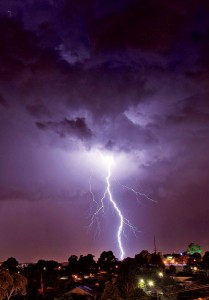When Lightning Strikes—Tips to keep you and your family safe this summer
By Mary Kay Kleist
June 2012 View more Health & Fitness
 The start of summer often brings the rumble of thunder. While lightning displays in the summer sky can be quite spectacular, lightning is completely unpredictable, and can be deadly. Lightning kills more Americans every year than hurricanes or tornadoes. It doesn’t matter if the storm is large or small, or if it creates one bolt or thousands of bolts in a single storm.
The start of summer often brings the rumble of thunder. While lightning displays in the summer sky can be quite spectacular, lightning is completely unpredictable, and can be deadly. Lightning kills more Americans every year than hurricanes or tornadoes. It doesn’t matter if the storm is large or small, or if it creates one bolt or thousands of bolts in a single storm.
Imagine you’re in the middle of playing a round of golf. You see the sky getting dark but you try to squeeze in one more hole. Even though you don’t see lightning or hear thunder in the distance, you could be putting your safety in jeopardy. Statistics show that most people are struck or killed by the first and last flash of a storm. Golfers, who are anxiously waiting the passing of the storm in the clubhouse, could be walking into trouble if they head back out on the course too soon. Even though the storm may appear to be over, lightning can travel 10 miles from the main thunderstorm. A good rule of thumb is that if you hear thunder, you are close enough to be struck by the lightning. Stay inside until 30 minutes after the last rumble of thunder.
The National Weather Service also offers these lightning safety tips to keep you and your family safe this summer:
Where To Go
The safest location during a thunderstorm is inside a large, enclosed structure with plumbing and electrical wiring. These include shopping centers, schools, office buildings and homes. If lightning strikes the building, the plumbing and wiring will conduct the electricity more efficiently than a human body. If no buildings are available, an enclosed vehicle makes a decent alternative.
Where Not To Go
Not all types of buildings or vehicles are safe during thunderstorms. Buildings which are not safe have enclosed openings. These include beach shacks, metal sheds, picnic shelters, carports and baseball dugouts. Porches are dangerous as well. Convertible vehicles offer no safety from lightning, even if the top is up. Other vehicles which are not safe during lightning storms are those which have open cabs, such as golf carts, tractors and construction equipment.
What To Do
Once inside a sturdy building, stay away from electrical appliances and plumbing fixtures. An interior room is ideal. If you are inside a vehicle, roll the windows up, and avoid contact with any conducting paths leading to the outside of the vehicle.
What Not To Do
Lightning can travel great distances through power lines, especially in rural areas. Do not use electrical appliances, especially corded telephones unless it is an emergency. Computers are also dangerous, especially if they are connected to phone lines and electrical cords. Do not take a shower or bath.
Lightning Survivors
I have interviewed lightning strike survivors over the years. Even though they survived the storm, their health and lives are forever changed. Lightning injuries can often result in immediate symptoms like intense headaches, ringing in the ears, dizziness, difficulty sleeping, or even short-term memory loss. The victim may also experience changes in their personality, with dramatic mood swings. It can be very hard to focus on everyday tasks. Over time, the victim can experience seizure-like activity. They can have difficulty carrying on a conversation and become frustrated when they can’t remember people or their job responsibilities.
So as you have fun with family and friends this summer, remember you can’t control the weather, but you can be alert and ready when thunder roars.


